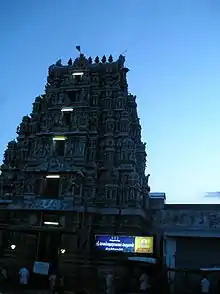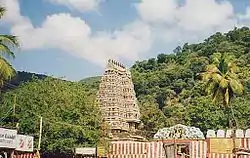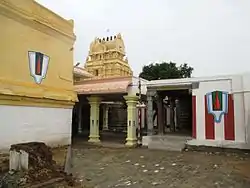Thirumalisai Alvar
Thirumazhisai Alvar (Born: Bhargavar 4203 BCE - 297 AD) is a Tamil saint revered in the Srivaishnavism school of south India, in Tondai Nadu (now part of Kanchipuram and Tiruvallur districts). He was born in 4203 BCE.[1][2] The legend of this saint devotees of Srivaishnavism believe that he was the incarnation of Vishnu's disc, Sudarshana. He is believed to have been born at Jagannatha Perumal temple, Tirumazhisai by divine grace.
Thirumazhisai Alvar | |
|---|---|
| Personal | |
| Born | |
| Religion | Hinduism |
| Philosophy | Vaishnava Bhakti |
| Religious career | |
| Literary works | Thiruchchanda Viruththam Naanmugan Thiruvandhadhi |
| Honors | Alvar saint |
A childless tribal couple called Tiruvaalan and Pankaya Chelvi engaged in cutting canes found the child and took it home. The couple also had a son named Kanikannan who was a disciple of Thirumazhisai Alvar.
Thirumazhisai Alvar proclaimed that he didn't belonged to Brahmin, Kshatriya, Vaishya & Shudra in one of his couplets as he was considered (Avarna) beyond caste bound person. He was the only azhwar saint who lived for 4500 Years.
Azhwars
The word azhwar means the one who dives deep into the ocean of the countless attributes of god. Azhwars are considered the twelve supreme devotees of Vishnu, who were instrumental in popularising Vaishnavism. The religious works of these saints in Tamil, songs of love and devotion, are compiled as Nalayira Divya Prabandham containing 4000 verses and the 108 temples revered in their songs are classified as Divya desam.[3][4] The saints had different origins and belonged to different castes. As per tradition, the first three azhwars, Poigai, Bhutha and Pey were born miraculously. Tirumizhisai was the son of a sage, Thondaradi, Mathurakavi, Peria and Andal were from brahmin community, Kulasekhara from Kshatria community, Namm was from a cultivator family, Tirupana from panar community and Tirumangai from kazhwar community. Divya Suri Saritra by Garuda-Vahana Pandita (11th century AD), Guruparamparaprabavam by Pinbaragiya Perumal Jiyar, Periya tiru mudi adaivu by Anbillai Kandadiappan, Yatindra Pranava Prabavam by Pillai Lokacharya, commentaries on Divya Prabandam, Guru Parampara (lineage of Gurus) texts, temple records and inscriptions give a detailed account of the azhwars and their works. According to these texts, the saints were considered incarnations of some form of Vishnu. Poigai is considered an incarnation of Panchajanya (Krishna's conch), Bhoothath of Kaumodakee (Vishnu's Mace/Club), Pey of Nandaka (Vishnu's sword), Thirumalisai of Sudarshanam (Vishnu's discus), Namm of Vishvaksena (Vishnu's commander), Madhurakavi of Vainatheya (Vishnu's eagle, Garuda), Kulasekhara of Kaustubha (Vishnu's necklace), Periy of Garuda (Vishnu's eagle), Andal of Bhoodevi (Vishnu's wife, Lakshmi, in her form as Bhudevi), Thondaradippodi of Vanamaalai (Vishnu's garland), Thiruppaan of Srivatsa (An auspicious mark on Vishnu's chest) and Thirumangai of Saranga (Rama's bow). The songs of Prabandam are regularly sung in all the Vishnu temples of South India daily and also during festivals.[4][5]
Early life
The name of the Azhwar comes from his birthplace, Thirumazhisai, a suburb in modern day Chennai.[6]
According to Puranas, it was the onset of Kali Yuga (the dark age). Lord Vishnu was worried about the next incarnation his weapon to take because, Kali Yuga has started and he didn't know how his relations will spend their life on Earth since they had to spend a normal Human life. It was the onset of Kali Yuga, and Vishnu was worried about this and when enquired he told the terrible attitudes of people during the Kali Yuga and how can his dear ones can spend their life on Earth in such a dark age, when Sudarshana intervened and volunteered to be born on Earth when Vishnu objected again exclaiming the attributes of Kali Yuga. Sudarshana still obliged leaving Vishnu tearful. He had a weird birth story. This was when Bhargava maharishi was in a long tapa (penance) to please Vishnu, as usual to spoil his penance Indra sent an apsara for which he succeeded. After enjoying worldly pleasures the apsara left to heaven leaving back the baby born to them. Due to his attachment to continue the penance, he cannot take care of the child and left it on the ground. Many days passed and the baby was crying a lot and nobody turned around to look after him. He was covered with blood and worms and mosquitoes are continuously biting him. Worried, Vishnu and Lakshmi descended to Earth and touched the baby and disappeared. The baby was transformed into a handsome young boy. The boy being Sudharshana Chakra himself was devoid of any illness though was hungry for many many days. All were wondering how could this be possible when a childless couple adopted him. Even then he did not accept single grain of rice from the couple. One day, an old man and woman paid visit to this boy. The boy was happy to see them when they asked to go for a short walk along the temple premises. The boy obliged and the old man and woman seemed worried and when enquired, they answered that the sadness cannot be prevented in that age. Still he enquired to which the old couple answered they are yearning for parental affection, to which this boy seemed too casual and wrote two pasurams in praise of Vishnu and miraculously the old couple was transformed into young and good looking couple. They thanked the boy a lot and this boy was too happy because in the Kali Yuga period people are also being thankful to which he wrote another pasuram in praise of Lord Vishnu. The boy asked the couple to read the pasuram, and the couple was blessed with a baby boy whom they named as Kanikannan. Kanikannan grew up to be a disciple of the boy. One time, after the demise of the couple, knowing about the glory of the boy and his disciple Kanikannan, the jealous chola king who was a strong shaivaite ordered him to sacrifice Vaishnavism and practice Shaivism to which they declined, and accordingly they were subjected to death. Somehow both escaped the place to Srirangam. Another news reached their ears that they (the boy and Kanikannan) must be killed or must be exiled, if found anywhere. Worried, they visited all Vishnu temples in Tamilnadu, and when they paid the tributes to Ranganatha Perumal in Srirangam, one amazing and miracle happened. The statue of Ranganatha woke up and stopped these two, and they declined stating it is a duty for the citizens to obey the order of their ruler. Next, they both visited Kumbakonam Sarangapani temple, and the statue again rose, and this time both obliged. Days later Kanikannan died and later the boy went to do tapa (penance) in Ramaswamy Temple in Kumbakonam. One day when he was doing penance a Vaishnava Acharya visited the place to find that the boy's heart beat has stopped, and he built a Brindavanam around him. Years later the boy woke up still as a youth and the acharya who was working in the temple found that he is still alive. The acharya apologized to him and the boy forgave him and he let the samadhi be there. He also stated that he would live till the end of Kali Yuga for Mangalasasanam for Kalki avatar and he is still continuing his tapa near Ramaswamy Temple. The boy was called Thirumalisai Alvar thereafter and his samadhi near Ramaswamy Temple in Kumbakonam (Tamil Nadu) is called Thirumalisai Alvar samadhi. He is below that samadhi, doing penance.
An alternative is that he was born to Bhargava maharishi and his wife Kanakangi after an unusual 12 months stay in the womb. The foetus came out as just a lifeless lump of flesh with no arms and legs. The couple were terribly depressed and with unwillingness left it under a bamboo bush and proceeded with their spiritual journey. Vishnu appeared with Lakshmi and blessed the "flesh" with their kataksham and it turned into an lively human being.
He was later picked up with both the arms affectionately by a tribal named Thiruvalan. A really blessed couple Thiruvalan and pankajavalli, was overwhelmed by the grace of god for this gift of a baby. The boy grew on to become Thirumazhisai azhwar. He also has an eye on his right leg. He lived up to 10 years of age in a hamlet near thirumazhisai village named as Pirayampathu. This Alwar was an incarnation of Sudarsana Chakra ( the divine discus of Lord Vishnu).
Thirumazhisai Alwar decided to learn about all other religions. He also got initiated into Vaishnavism by Pey Alwar. After visiting several temples, he reached Tiruvekka, the birthplace of Poigai Alwar.
Displeasing Pallava king
Legend also says that when Kanikannan, his disciple displeased the pallava king for not agreeing to restore the king's youth. Earlier on he granted youth to an old unmarried maid of the temple. The king married that woman but he himself was an old man and thus wanted to enjoy life as a youth with his new wife. Tirumalisai refused him and the king decided to banish him. Tirumalisai Alvar asked the God from the temple, Yathotkari, to leave with him.
Tamil
கணிகண்ணன் போகின்றான் காமரு பூங் கச்சி
மணிவண்ணா! நீ கிடக்க வேண்டா
செந்நாப் புலவனும் போகின்றேன் நீயும் உன்றன்
பை நாகப்பாயை சுருட்டிக் கொள்
Transliteration
KanikaNNan Poginraan Kaamaru poong Kachi
ManivaNNaa! Nee Kidakka Vendaa
Sennaap Pulavanum Poginren Neeyum Unran
Pai Naagappaayai Suruttik KoLL
KanikaNNan is going out of kAnchi Oh! Manivanna!, You don't have to lie here anymore. Since, as the fluent poet that I am also leaving with him, you also roll your serpent bed and follow me"And, accordingly all of them left KAnchipuram
Vishnu is said to have rolled up the snake Sesha like a mattress and left with him.
Mangalasasanam
There are 216 of his paasurams in the 4000 Divya Prabhandham. His first Prabandham named Thiruchchanda Viruththam contains 120 hymns and starts from 752 paasuram and ends at 871 paasuram. The second Prabandham of Thirumazhisai Alvar is titled Naanmugan Thiruvandhadhi and it contains 96 verses. The work of Naanmugan Thiruvandhadhi starts from 2382 paasuram and ends at 2477 paasuram.
He has sung in praise of 20 temples.[7]
| S.No. | Name of the temple | Location | Photo | Presiding deity | Notes/Beliefs |
|---|---|---|---|---|---|
| 1 | Thiru Kapistalam/ | 10.946°N 79.256°E | |||
| 2 | Thiru Anbil.[8] | Anbil Tiruchirappalli district 10.86°N 78.88°E |
 |
Sundararaja Perumal Azhagiya Nambi Perumal |
The temple is located on the Northern bank of the river Kollidam, at a distance of 25 km (16 mi) from Trichy. King Sundara Chola who ruled the area was a devotee of the temple and during each of his innumerable victories in wars, he showered a lot of wealth on this temple. His prime minister Anirudha Brahmarayar is believed to be from Anbil, the village where the temple is located. The copper plates having the records from the Chola period from Anbil indicate generous contribution from the Medieval Cholas indicate various gifts to the temple.[9][10] |
| 3 | Thiruevvul.[8] | 13.143°N 79.907°E |  |
||
| 4 | Thiru urakam.[11] | 12.839°N 79.705°E |  |
||
| 5 | Thiruvallikeni.[12] | 13.053884°N 80.277020°E |  |
||
| 6 | Thirupper Nagar. | 10.839282°N 78.889070°E | |||
| 7 | Thirukkurungudi.[13] | 8.436096°N 77.565933°E |  |
||
| 8 | Tiruvekkaa.[14] | 12.824°N 79.712°E |  |
||
| 9 | Tiruppatakam.[15] | 12.842°N 79.696°E |  |
||
| 10 | Thirukoshtiyur.[16] | 10.060°N 78.560°E |  |
||
| 11 | Thirukkudandhai.[16] | 10.959°N 79.375°E |  |
||
| 12 | Thiruvenkadam . | 13.683304°N 79.347406°E |  |
||
| 13 | Tirupparkatal. | .jpg.webp) |
|||
| 14 | Srirangam. | Srirangam, Trichy district Tamil Nadu 10.8625°N 78.689722°E |
 |
Ranganayagi Ranganathar (Periya Perumal) |
Srirangam temple is often listed as the largest functioning Hindu temple in the world, the still larger Angkor Wat being the largest existing temple. The temple occupies an area of 156 acres (631,000 m²) with a perimeter of 4,116m (10,710 feet) making it the largest temple in India and one of the largest religious complexes in the world.[17][18] The annual 21-day festival conducted during the Tamil month of Margazhi (December–January) attracts 1 million visitors.[19] |
| 15 | Azhagar Kovil.[13] | 10.074°N 78.213°E |  |
||
| 16 | Appakkudathaan Perumal Temple.[13] | Koviladi, Trichy district Tamil Nadu 10.86°N 78.88°E |
 |
Indravalli Appala Ranganatha Perumal |
The temple has inscriptions from the 18th year of the reign of Aditya Chola.[20] The recorded inscriptions in this temple are numbered 283, 300, 301 and 303 of 1901.[21] The temple is one of the five Pancharanga Kshetrams (also called Pancharangams,
meaning the "five Rangams or Ranganathas"), a group of five Hindu temples on the banks of the Kaveri River dedicated to Ranganatha, a form of Vishnu.[22][23] |
Notes
- L. Annapoorna (2000). Music and temples, a ritualistic approach. p. 23. ISBN 9788175740907.
- Sakkottai Krishnaswami Aiyangar (1911). Ancient India: Collected Essays on the Literary and Political History of Southern India. pp. 403–404. ISBN 9788120618503.
- Rao, P.V.L. Narasimha (2008). Kanchipuram – Land of Legends, Saints & Temples. New Delhi: Readworthy Publications (P) Ltd. p. 27. ISBN 978-93-5018-104-1.
- Dalal 2011, pp. 20-21
- Ramaswamy, Vijaya (2007). Historical Dictionary of the Tamils. Scarecrow Press. p. 211. ISBN 9780810864450.
- Ramakrishna Mission (1998). "Bulletin of the Ramakrishna Mission Institute of Culture". 49. The Institute: 535–538. Cite journal requires
|journal=(help) - Pillai, M. S. Purnalingam (1904). A Primer of Tamil Literature. Madras: Ananda Press. pp. 182–83.
- Kodayanallur Vanamamalai 2001, p. 51
- "Sri Sundararaja Perumal temple". Dinamalar. Retrieved 9 September 2013.
- Ayyar, P. V. Jagadisa (1982). South Indian Shrines: Illustrated. New Delhi: Asian Educational Services. p. 533. ISBN 9788120601512.
- Kodayanallur Vanamamalai 2001, p. 52
- T. 2002, p. 85
- Kodayanallur Vanamamalai 2001, p. 59
- Kodayanallur Vanamamalai 2001, p. 70
- T. 2002, p. 86
- Kodayanallur Vanamamalai 2001, p. 58
- Mittal, Sushil; Thursby, G.R. (2005). The Hindu World. New York: Routelge. p. 456. ISBN 0-203-67414-6.
- Vater, Tom (2010). Moon Spotlight Angkor Wat. USA: Perseus Books Group. p. 40. ISBN 9781598805611.
- Jones, Victoria (2004). Wonders of the World Dot-to-Dot. New York: Sterling Publishing Co., Inc. p. 4. ISBN 1-4027-1028-3.
- Jouveau-Dubreuil, Tony (1994). The Pallavas. New Delhi: Asian Educational Services. p. 77. ISBN 81-206-0574-8.
- Jouveau-Dubreuil, G. (1994). Pallava Antiquities – 2 Vols. Asian Educational Services. p. 13. ISBN 978-81-206-0571-8.
- S., Prabhu (16 September 2010). "Restoring the glory of a temple". The Hindu. Retrieved 9 September 2013.
- Soundara Rajan, Kodayanallur Vanamamalai (2001). Concise classified dictionary of Hinduism. New Delhi: Concept Publishing Company. p. 65. ISBN 81-7022-857-3.
References
- B. S., Chandrababu; S., Ganeshram; C., Bhavani (2011). History of People and Their Environs. Bharathi Puthakalayam. ISBN 9789380325910.
- Chari, S. M. Srinivasa (1997). Philosophy and Theistic Mysticism of the Āl̲vārs. Motilal Banarsidass Publishers. ISBN 9788120813427.
- Dalal, Roshen (2011). Hinduism: An Alphabetical Guide. Penguin Books India. ISBN 9780143414216.
- Kodayanallur Vanamamalai, Soundara Rajan (2001). Concise classified dictionary of Hinduism. New Delhi: Concept Publishing Company. ISBN 81-7022-857-3.
- T., Padmaja (2002). Temples of Kr̥ṣṇa in South India: history, art, and traditions in Tamilnāḍu. New Delhi: Shakti Malik. ISBN 81-7017-398-1.